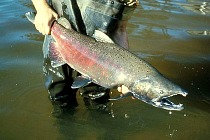Oregon fishery managers announced today that the upper Snake River will open to hatchery fall Chinook fishing on Monday, Sept. 1.
The river will be open from the Oregon –Washington border to the deadline below Hells Canyon Dam and will remain open until Oct. 31, or until a closure is announced. In addition, the reach from Cliff Mountain Rapid (at river mile 246.7) upstream to the deadline at Hells Canyon Dam will be open from Nov. 1-17.
The daily bag limit will be six adipose fin-clipped Chinook salmon. Anglers can also keep an unlimited number of fin-clipped jack Chinook. Chinook jacks are salmon between 15 and 24-inches long.
After decades of low numbers, fall Chinook returns to the Snake River have rebounded in recent years to the point that fishing can now be allowed, said Jeff Yanke, Oregon Fish and Wildlife fish biologist in Enterprise. This is the fifth year in a row that this fall Chinook fishery has been open after years of closure, Yanke added.
Fishery managers are expecting a run of 53,500 adult fall Chinook salmon, including 27,500 wild fish, to return to the Snake River above Lower Granite Dam this year.
“The reputation of this fishery is starting to grow, and each year more and more Oregon anglers are participating,” Yanke said.
In 2010, the first year the fishery was opened after years of closure, Oregon anglers accounted for 34 percent of the fishing effort and 36 percent of the harvest in Oregon boundary waters. By 2013 those numbers had grown to 44 percent of the effort and 60 percent of the harvest.
“We’re hoping that the huge return this year, combined with liberal bag limits, will encourage even more anglers to add Snake River Chinook to their list of fall fishing destinations, ” Yanke added.
Only barbless hooks may be used on this stretch of the Snake River, and anglers should consult the 2014 Oregon Sport Fishing Regulations for other rules that may apply.
Snake River fall Chinook migrate over 800 miles and pass eight mainstream dams to reach Hells Canyon, the farthest any salmon will travel in Oregon.









